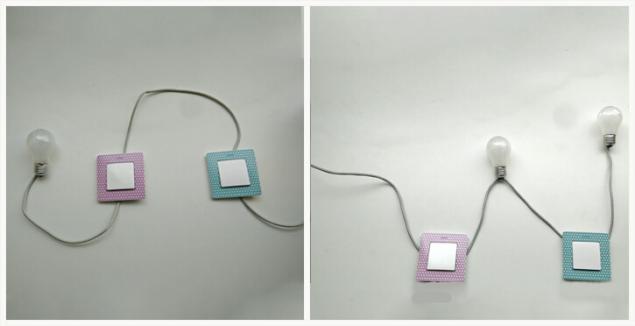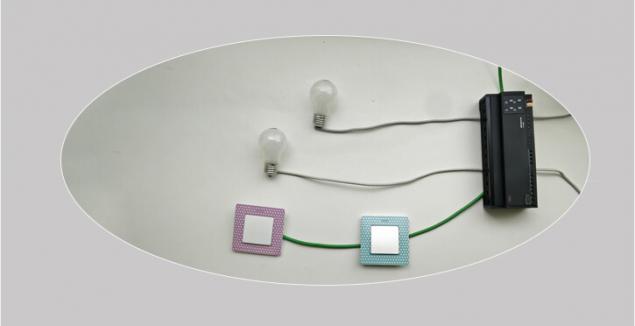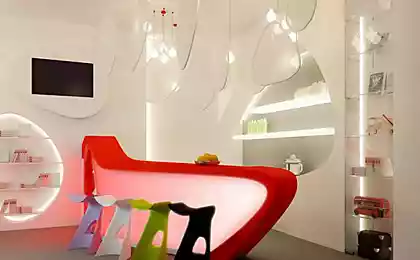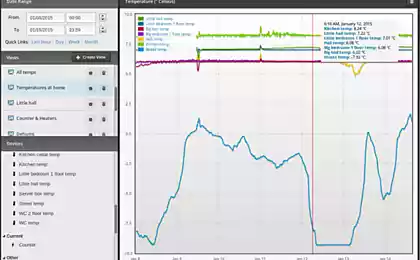779
Intelligent wiring system of "Smart house"
Repair work should always be performed "bound" for the future. Future plans for housing arrangement, type and amount of equipment used, the ability to easily change the settings of the room because of new circumstances (e.g., birth) – all this is taken into account in advance, at the stage of the project, thereby saving time and money. To a considerable extent as a private country houses.

"Smart house" — a system of intelligent management, combining engineering networks and equipment of the house. In recent years, the system "smart house" on everyone's lips – when carrying out communications in the cottage increasingly, the owner is considering the possibility to add automation. It is comfortable, modern, saves energy and provides a high level of security. However, the introduction of such a system is not limited to the banal purchase and installation of individual smart devices. Kettle or toaster with smart functions are good in themselves. But we are talking about more.
The project "Smart house" for the house or a large apartment recommended based on the "wired" home automation system. Such system involves specific wiring through which all engineering systems, appliances, cameras, sensors are connected in a single network. Therefore, its successful implementation must begin to be thought through in detail at the stage of construction or overhaul of the building.
This does not mean that the "smart" system is generally impossible to install without shtrobleniya walls in the house with a classic wiring. For this there are separate smart devices and wireless solutions, allowing to combine them into a single network, but a large number of devices and a large area of their placement wireless solution can become unstable. The functionality of such a "lightweight" system will be far behind the fully wired smart home.
What is this grid? What are its advantages? Really it is beneficial and what to consider for best results?
Looks like the wiring system of "Smart house"?It is worth to mention that the wiring of electrics under the "Smart home" requires a detailed project the Executive documentation for installation of cable, which indicated the location of the cable is made of electrical circuit boards and linking all elements. Often with classical electrical electrician decides how to organize the wiring. In the "Smart house" all decisions are made at the design stage and installation is strictly on a project.
The project "smart home" contains full documentation on wiring
From the point of view of electrical protection the project "Smart home" has all the usual attributes of a modern classic Postings: ouzo, differential automatic machines. As to the connection of terminal equipment with switches, there is one important caveat. In a simple grid of any device, for example, light bulb or group of directly connected power cable to the switch. Interrupting or closing the circuit, it turns on or off the light. In a more complex implementation may use multiple controls for potential disconnection from different places. But the essence remains the same. One wire through the switch (or through each of them, if more than one) goes to the light bulb.

A visual representation of a classical electrical circuits
In contrast, in the project "Smart house" wiring system involves the use of two types of lines:

In the automation system loads connected through switches and directly to the shield
What are the benefits and advantages of smart wiring?The obvious benefit of such a transaction in the project "Smart home" is the ability to automate and control any number of different devices (under devices here understand lighting, motorized blinds, air conditioned, AV equipment and the like). There is something else.
At first glance it may seem that the implementation of the project "Smart home" will require several times more cable than for classical transactions. But this is not so for two reasons:
Remains one important question you have to answer, wanting to create his project "Smart house": "What type of communication cable (bus) to use and what will be the geometry of its connection to numerous devices?"
View and topology information bus intelligent systemsFundamental to this issue are two factors which will depend on what type of tires to put in the project and what configuration when the strip need to adhere to:
But all this must be considered at the stage of creation of the project "Smart home", this is not a limitation in the use of "hybrid" systems when applied to different automation protocols or equipment from different manufacturers. Sometimes it can be the best solution for obtaining maximum efficiency. This needs to be provided in advance.
The automation Protocol KNX supports several communication mediums, including IP and radio. But most often use a special wire bus, which all connected equipment. The geometry of the connecting devices may take the form of:
As for the size of the premises, which can be implemented in the project "Smart home", they can be quite large, as intelligent KNX wiring has a maximum distance between instances of the connected equipment up to 700 m, and the length of the cable segment to 1000 meters.
The system of "Smart home" implies the particular rational option cable lines laying, in which the intermediate is used (between the control element and equipment) in the form of logic controllers. To support the work and efficient functioning of such a network, depending on the need, use, and other devices. Ways of wiring will depend on the provider of Protocol automation, its type (centralized or decentralized), the need to use equipment from other manufacturers.
To address those concerns and outline for themselves the concept of the future system, it is best to discuss these issues with the company — integrator of Smart home at a very early stage of major repairs or build a house. Then your building will be completely ready to not only be "smart" now, but easy to adapt to changing conditions that require adding, removing, or changing the configuration of smart devices.published
Source: remstd.ru/archives/intellektualnaya-elektroprovodka-v-sisteme-umnyiy-dom/

"Smart house" — a system of intelligent management, combining engineering networks and equipment of the house. In recent years, the system "smart house" on everyone's lips – when carrying out communications in the cottage increasingly, the owner is considering the possibility to add automation. It is comfortable, modern, saves energy and provides a high level of security. However, the introduction of such a system is not limited to the banal purchase and installation of individual smart devices. Kettle or toaster with smart functions are good in themselves. But we are talking about more.
The project "Smart house" for the house or a large apartment recommended based on the "wired" home automation system. Such system involves specific wiring through which all engineering systems, appliances, cameras, sensors are connected in a single network. Therefore, its successful implementation must begin to be thought through in detail at the stage of construction or overhaul of the building.
This does not mean that the "smart" system is generally impossible to install without shtrobleniya walls in the house with a classic wiring. For this there are separate smart devices and wireless solutions, allowing to combine them into a single network, but a large number of devices and a large area of their placement wireless solution can become unstable. The functionality of such a "lightweight" system will be far behind the fully wired smart home.
What is this grid? What are its advantages? Really it is beneficial and what to consider for best results?
Looks like the wiring system of "Smart house"?It is worth to mention that the wiring of electrics under the "Smart home" requires a detailed project the Executive documentation for installation of cable, which indicated the location of the cable is made of electrical circuit boards and linking all elements. Often with classical electrical electrician decides how to organize the wiring. In the "Smart house" all decisions are made at the design stage and installation is strictly on a project.
The project "smart home" contains full documentation on wiring
From the point of view of electrical protection the project "Smart home" has all the usual attributes of a modern classic Postings: ouzo, differential automatic machines. As to the connection of terminal equipment with switches, there is one important caveat. In a simple grid of any device, for example, light bulb or group of directly connected power cable to the switch. Interrupting or closing the circuit, it turns on or off the light. In a more complex implementation may use multiple controls for potential disconnection from different places. But the essence remains the same. One wire through the switch (or through each of them, if more than one) goes to the light bulb.

A visual representation of a classical electrical circuits
In contrast, in the project "Smart house" wiring system involves the use of two types of lines:
- power (220 Volts to power the equipment);
- information (low-voltage).

In the automation system loads connected through switches and directly to the shield
What are the benefits and advantages of smart wiring?The obvious benefit of such a transaction in the project "Smart home" is the ability to automate and control any number of different devices (under devices here understand lighting, motorized blinds, air conditioned, AV equipment and the like). There is something else.
At first glance it may seem that the implementation of the project "Smart home" will require several times more cable than for classical transactions. But this is not so for two reasons:
- low voltage communication cable (bus) passes through all the switches at home, connecting them to the modules in the dashboard – so its length depends more on room size than the number of lamps, sensors and other devices (but with the selected topology "star" will be the opposite).
- the power wire runs from the panel to each device or group, bypassing the circuit breakers responsible for their work, so its length is less than the length of the same cable at the classic wiring.
Remains one important question you have to answer, wanting to create his project "Smart house": "What type of communication cable (bus) to use and what will be the geometry of its connection to numerous devices?"
View and topology information bus intelligent systemsFundamental to this issue are two factors which will depend on what type of tires to put in the project and what configuration when the strip need to adhere to:
- Today, there are a large number of manufacturers offering their automation protocols. Creston, KNX, HDL, Teletask, Vantage is not a complete list of everything available on the market of "smart" systems. For the Internet, television and telephony use different wires depending on the service provider and other factors. Likewise, for most of the automation protocols required type data bus that must be taken into account at the stage of the project.
- How exactly will run the wire network topology will depend on the type of the introduced system. There is the concept of decentralized systems, each element for processing incoming signals has the intelligent function. In this "Smart house" there is no need to send streams of commands on the CPU. In another case, the signals from all switches, you must first have the "heart" of the system, and then to the actuators.
But all this must be considered at the stage of creation of the project "Smart home", this is not a limitation in the use of "hybrid" systems when applied to different automation protocols or equipment from different manufacturers. Sometimes it can be the best solution for obtaining maximum efficiency. This needs to be provided in advance.
The automation Protocol KNX supports several communication mediums, including IP and radio. But most often use a special wire bus, which all connected equipment. The geometry of the connecting devices may take the form of:
- line;
- tree;
- star.
As for the size of the premises, which can be implemented in the project "Smart home", they can be quite large, as intelligent KNX wiring has a maximum distance between instances of the connected equipment up to 700 m, and the length of the cable segment to 1000 meters.
The system of "Smart home" implies the particular rational option cable lines laying, in which the intermediate is used (between the control element and equipment) in the form of logic controllers. To support the work and efficient functioning of such a network, depending on the need, use, and other devices. Ways of wiring will depend on the provider of Protocol automation, its type (centralized or decentralized), the need to use equipment from other manufacturers.
To address those concerns and outline for themselves the concept of the future system, it is best to discuss these issues with the company — integrator of Smart home at a very early stage of major repairs or build a house. Then your building will be completely ready to not only be "smart" now, but easy to adapt to changing conditions that require adding, removing, or changing the configuration of smart devices.published
Source: remstd.ru/archives/intellektualnaya-elektroprovodka-v-sisteme-umnyiy-dom/
The technique of "Healing Memory" of migraine and severe headaches
Turn a fireplace into a full-fledged source of heat for the entire house























